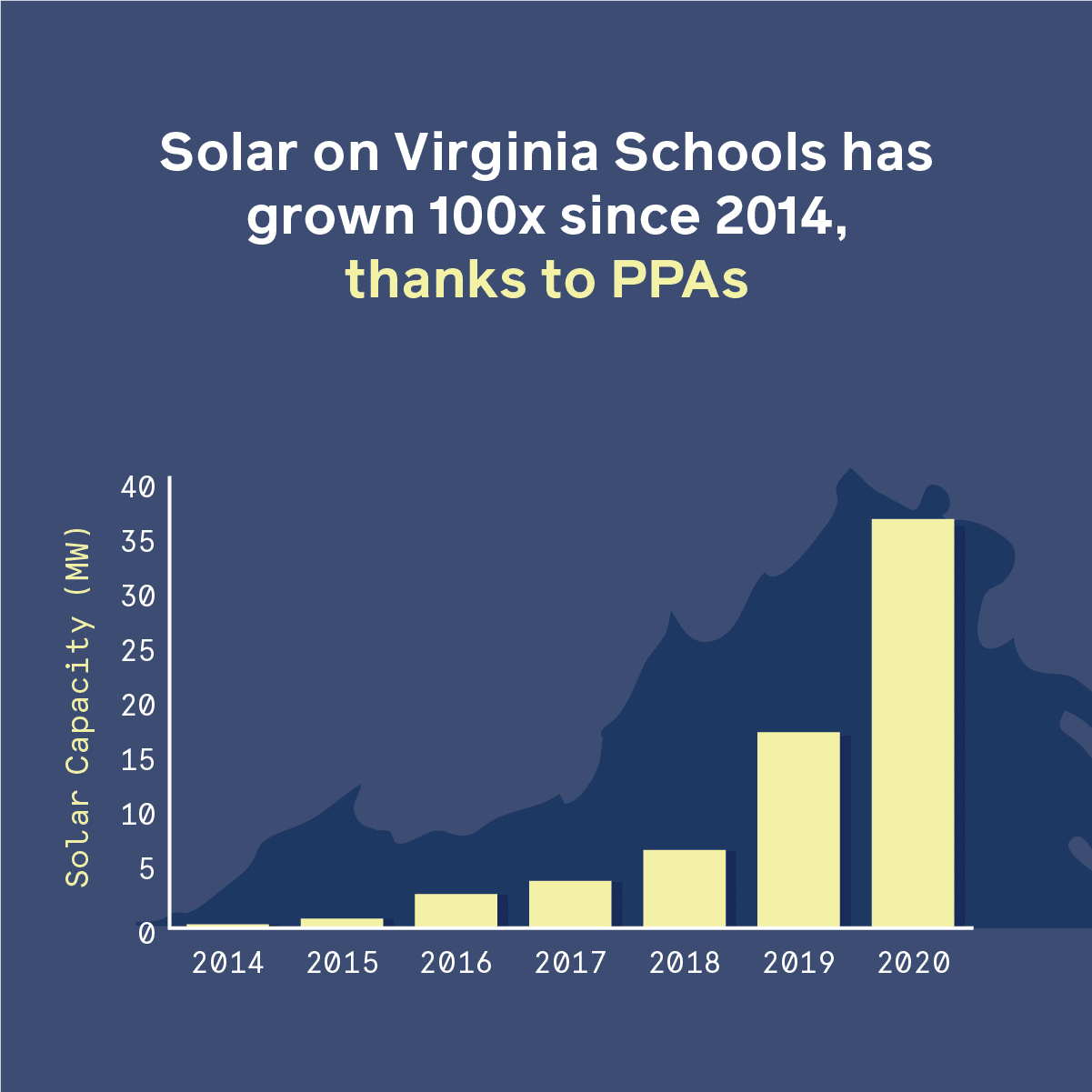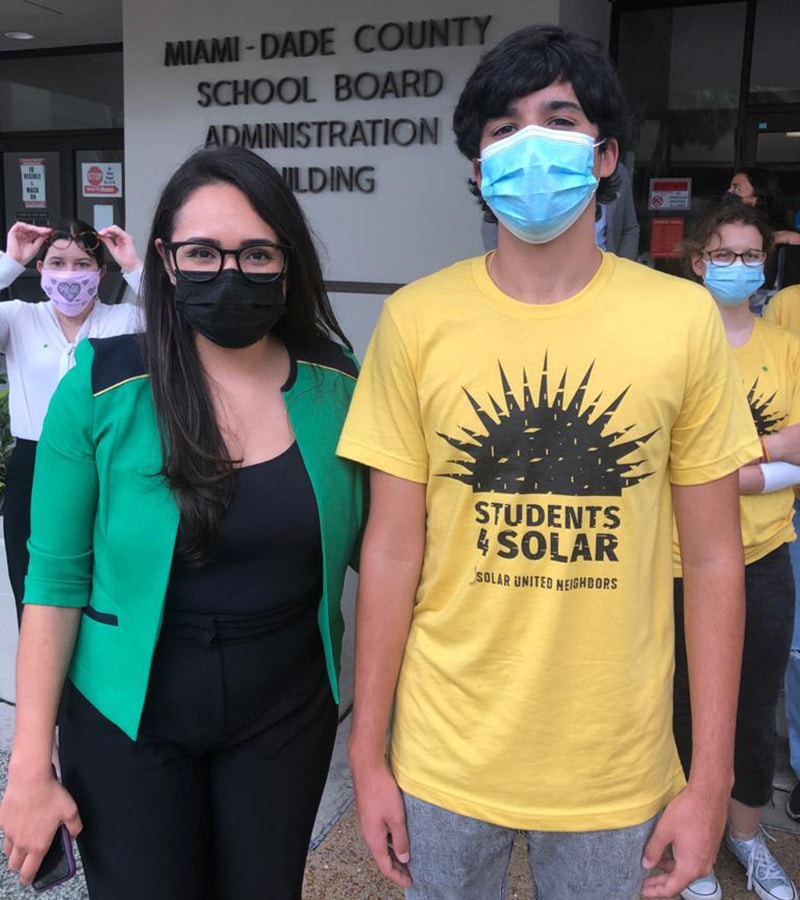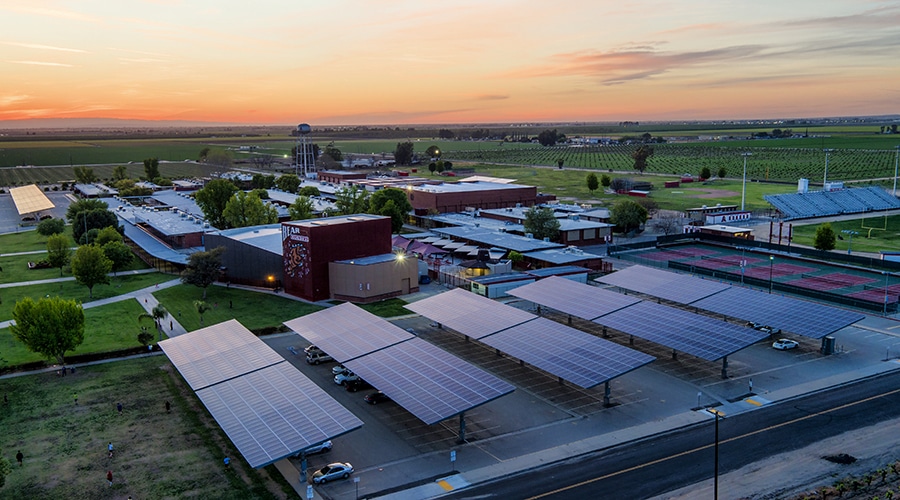This article is from the May 12, 2021, issue of Flip the Script, a weekly newsletter moving you from climate stress to clean energy action. Sign up here to get it in your inbox (and share the link with a friend).
There’s a growing movement among U.S. schools to choose renewable energy sources, with many switching to electric buses and powering their buildings using solar energy. In most cases, they’re taking advantage of a supportive policy environment that helps them to seriously reduce the costs of going solar and to reap numerous other benefits. But in a few states—like Virginia, Wisconsin, Florida, and West Virginia—gaining access to low-cost solar isn’t as easy, and school districts are fighting for the right to capture their power from the sun.
In most states, schools fund solar through a power purchase agreement (PPA), a financing approach where a third party (either a utility or solar developer) installs, owns, and operates the new solar array. The school then buys the electricity produced from the panels at a fixed rate, usually at a cheaper cost than buying it from the grid. Crucially, third-party financing through PPAs has enabled school districts to go solar and reap much-needed bill savings from day one, without facing the upfront cost of purchasing and installing the panels or paying ongoing maintenance costs.
Across the U.S., 29 states (and D.C.) allow third-party financing arrangements, such as PPAs, to reduce the upfront cost of solar. But PPAs aren’t an option everywhere, and they’re actually illegal in seven states, where utilities continue to oppose practical tools like third-party financing. In places where PPAs aren’t allowed, schools looking to go solar generally have to find another way to cover the cost of the panels, or they just don’t take the leap because of the high upfront expense.
Fortunately, communities in several states are fighting for equal access to (cheaper) solar, hoping to produce their own energy while saving money and creating local jobs. Here are a few examples where the fight is under way:
Removing utility roadblocks to solar in southwest Virginia
In recent years, Virginia has risen to the top in school solar installations, and now ranks eighth nationwide. But access to solar has varied across the state, depending on which utility company provides power to the local community. Many school districts located in the service area of Dominion Energy, the state’s biggest utility, have funded large solar projects through third-party PPAs. Since 2014, when Dominion authorized the use of PPAs in its territory, the amount of solar installed at Virginia schools has grown by over a hundredfold. Fairfax County Public Schools, the tenth largest school district in the country, is using a PPA to put solar on 87 schools with no upfront costs and expects to see long-term energy cost savings of $60 million.

Meanwhile, in the state’s rural southwest region, the amount of solar installed on schools is tiny—equivalent to what can be installed at one home. Appalachian Power has yet to give public entities access to third-party PPAs, and communities have been fighting for years to change that. In March, a new law was passed that requires the utility to provide access to PPAs to schools and localities in its territory. But the utility continues to drag its feet on finalizing the new solar contract to authorize PPAs, and school districts across the region are calling for immediate, fair, and equitable access to this critical financing tool.
Fighting for third-party solar financing in Wisconsin
Solar advocates in Wisconsin are gearing up for a similar fight. In February, the Midwest Renewable Energy Association (MREA) and Earthjustice filed a lawsuit in state court to open up solar and other clean energy opportunities for communities. In its filing, MREA asks the court to ensure that the Public Service Commission does not illegally interfere with competitive clean energy alternatives and instead sticks to its role of regulating monopoly utility companies.
Specifically, the lawsuit challenges unlawful guidance documents from the Commission that discourage electricity consumers (including school districts) from using third-party financing for solar systems on their properties. The current guidance, which prevents people from reaping utility bill savings from solar, essentially limits solar access to only those who can afford to buy the panels outright, thus discriminating against lower-income customers. “We’re not asking for favorable treatment. We’re asking for fair treatment. Clean energy alternatives to the monopoly utility model can stand on their own. We’re asking the [Commission] to stop holding them back,” said MREA director Nick Hylla.
Pushing to make PPAs legal in Florida
The fight to allow PPAs continues in Florida, which ranks 24th in the nation for installed solar capacity at schools, despite being the “sunshine state.” Florida is one of only seven states in the country to explicitly ban PPAs, even though it would stand to gain 25,000 new jobs and spur $4 billion in economic investment if PPAs were legalized.
In March, Generation180 and Solar United Neighbors joined together with 64 schools, localities, universities, and nonprofits to call on state lawmakers to endorse bills that would open up access to PPAs. Miami-Dade County Public Schools, the fourth largest district in the country, became a supporter of PPA legislation thanks to advocacy efforts lead by local high school students and parents at MAST Academy.
-

Luisa Santos, Miami-Dade School Board, and Thomas Brulay, MAST Academy
MAST Academy set out to become first Florida school to achieve net-zero energy and net-zero waste. After learning that they would need PPAs to fund a sizable solar array, MAST students gathered over 1,000 petition signatures and wrote to newspapers in support of legalizing PPAs. They convinced the leaders of the district, which has an annual electricity bill of $65 million, that investing in clean energy would reap tremendous financial, educational, and health benefits. On the day before Earth Day, it became the first district in the South to commit to 100% clean energy by 2030.
Shortly after that commitment was made, the Florida legislature failed to advance any bills enabling PPAs, a necessary step for the district to meet its goals. If Miami-Dade County Public Schools could utilize PPAs to install an average-sized (250 kilowatt) solar system at every school, it could take a giant leap towards its energy goals. While paying no upfront costs, they’d save approximately $3 million a year—money that could be directed toward teaching and educational tools, and improve student health and safety.
Expanding solar access in West Virginia—but with conditions
In contrast, West Virginia has made welcome progress in updating antiquated electricity regulations. A coalition of businesses, local governments, elected officials, and community organizations, has been pushing for access to PPAs in the ‘Mountain State’ for several years. Last month, they succeeded in making West Virginia the 29th state to allow PPAs.The state legislature passed a bill exempting solar PPAs from falling under the jurisdiction of the state Public Service Commission. The law is designed to encourage retail customers (like schools) to invest in solar energy by specifying that solar energy systems located on and serving specific premises do not constitute “a public service.”
While access to this funding method builds a new runway for solar to take off across the state, the new law comes with conditions that limit this growth. For example, the total of all PPAs (plus net metering arrangements for selling power back to the grid) for a given utility cannot exceed a cap of 3 percent of the utility’s total customer peak demand during the previous year. The law also limits how much solar power a customer can generate onsite to no more than 25 kilowatts for residential, 500 kilowatts for commercial and 2,000 kilowatts for industrial. Even with these limits, this is a big win that will help a state known for coal to turn towards the sun.
If you want to help advocate for your school to go solar, check out our Solar for All Schools page for a map of all solar schools and tools to help your school do it.















